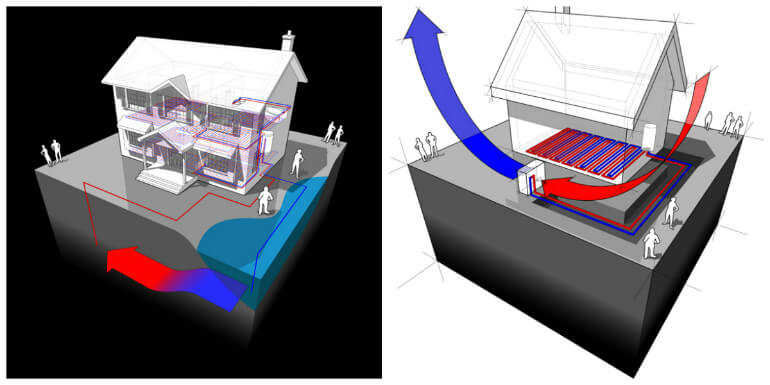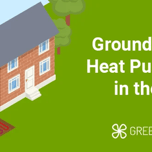Answer these simple questions and we will find you the BEST prices
Which type of solar quotes do you need?
It only takes 30 seconds
100% free with no obligation

Get up to 4 quotes by filling in only 1 quick form

Install a heat pump for less with the BUS grant

We’ve helped over 500,000 homeowners reduce their carbon footprint
- GreenMatch
- Compare
- types
- Comparing Air to Water and Water to Water Heat Pumps
Comparing Air to Water and Water to Water Heat Pumps
The Growing Popularity of Heat Pumps
Given the constant rise in energy prices and the negative consequences the large scale exploitation of traditional energy sources (fossil fuels, coal) inflicts on the environment, the ‘business as usual’ approach we adopted as to the way we power our homes for the past 50-60 years, has to be reconsidered. Moreover, it appears that the much-needed change is taking place already, with more and more households across the UK and worldwide endorsing a more sustainable lifestyle, by turning to renewable energy sources when it comes to power generation.
In the midst of this ongoing struggle between the proven reliability of traditional heating technologies and the untapped potential of new renewable energy heating solutions, the heat pump has proved its relevance and usefulness as an eco-friendly alternative to conventional household heating.
In the following lines of this short but, we hope, insightful post we decided to address some of the features that are characteristic for one of them, maybe less common but not less-efficient, heat pumps: namely, the air to water and water to water.
Ready to take the first step towards a more sustainable and cost-effective heating solution? Get in touch with our network of professional providers to learn more about how heat pumps can benefit your home or business. We'll provide you with up to 4 free, no-obligation quotes and guide you through the process from start to finish. Get started by simply clicking the link below:
- Quotes from local engineers
- Payment by finance available
- Save £7,500 with BUS grant
It only takes 30 seconds



Air to Water - Water to Water: Which One Is Better?
There is an unfounded public perception that water to water heat pumps (ground water heat pumps) are generally more efficient than air to water heat pumps or air to air heat pumps in the UK, and therefore more profitable to operate. However, the practice shows that even if conceptually different, the heat pumps (both the air to water and the water to water) will bear similar operational costs, under the condition that both of the systems exhibit the same nominal power ratings. Below we explain why the exploitation costs are more or less the same for both systems, even if the functioning principles of both heating appliances are slightly different.

Air to Water Heat Pump vs Water to Water Heat Pump
During the cold season, the fluids in the ground collector of the water to water heat pump, stabilise slightly below the freezing point, while the average air temperature that is indrawn by the air to water heat pump is about +4 degrees Celsius. In contrast, the air to water heat pump takes more heat from the air during the summer months, compared to the groundwater heat pump, which makes it less efficient when it comes to property cooling but quite handy for ensuring enough quantities of hot water. Here's how an air to water heat pump works:
- Even if the temperatures outside drop to -15 degrees Celsius, with a well-insulated house and a proper underfloor heating system, the air to water heat pump will still be able to ensure adequate heating on its own. Problems arise when the temperatures suddenly drop below -15 or -20 degrees Celsius, something an air to water pump will not be able to cope with as well as the water to water pump does, namely due to higher ground waters temperatures despite the outside weather conditions. This means, that in order to prevent heating disruptions during the cold winter days, one will have to turn on the gas or electric furnace, some of the air source heat pump systems (air to water and air to air) are equipped with, which will inevitably increase the heating costs.
- Although not at its highest efficient rate, the ground source heat pump (water to water or ground to water) will help you keep a certain ‘peace of mind’ even at significantly low temperatures outside. Even if the pump will have to run at a higher power rate than the usual one, the overall costs increase will be insignificant compared to those of air source heat pumps.
- The water to water heat pump’s ground collector that runs on a glycol-based coolant, whose density is greater and heat transfer properties are half the ones of the water, usually consumes more electricity than the air to water pump’s external unit fan. Therefore, this difference in electric power consumption covers the losses associated with the cyclic defrosting of the air to water heat pump evaporator.
- In addition to what was just mentioned above, one cannot disregard the initial investment costs, which in the case of air source heat pumps are usually much lower compared to the ones of ground source heat pumps. In fact, the price of an air to water pump equipment equals one of the water to water pump collector only and ensures a payback period that is close to 2 years.
All in all, the exploitation costs of both heat pumps are similar. This is because if one’s expenses are increasing in certain conditions, the other’s costs might be kept down under the same circumstances and vice versa. If you lose one end you might gain on the other, everything depends on the way you will use the pump, be it air to water or water to water.
Namely, this is the reason we invite you to fill out the form below with your personal preferences and information, and we will provide you with up to 4 different suppliers of heat pumps you can choose from. It is a free and non-obligatory process.
- Quotes from local engineers
- Payment by finance available
- Save £7,500 with BUS grant
It only takes 30 seconds



We strive to connect our customers with the right product and supplier. Would you like to be part of GreenMatch?




